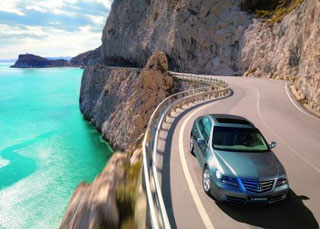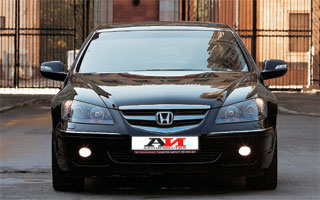Test drive Honda Legend sedan since 2006 sedan
Exclusive - Honda Legend against Mitsubishi Lancer Evo
 If you translate the title of the article from Russian into Russian, you will get a duel of the two most perfect all -wheel drive systems in the world, and their talented creators. We are talking about the AYC (ACTIVE YAW CONTROL), which is installed by the engineer Savaz, which is installed on Mitsubishi Lancer Evolution cars, starting from the fifth generation, and SH-AWD (Super Handling All-Wheel Drive), which appeared in 2004 on the flagship model of Honda Legend . Its creator is Yasuzh Shibahat, who has been working for Honda for the past 19 years. And before that, Yasuzh worked in Nissan, and it was he who came up with a full -wheel drive system for another legend of the Japanese auto industry - Nissan Skyline GT -R. Yes, I almost forgot, the ATTS traction system for the Prelude compartment, and the VGS active steering system for the S2000 relatives came up with the same modest Japanese genius of Yasuzhi Shibahat.
If you translate the title of the article from Russian into Russian, you will get a duel of the two most perfect all -wheel drive systems in the world, and their talented creators. We are talking about the AYC (ACTIVE YAW CONTROL), which is installed by the engineer Savaz, which is installed on Mitsubishi Lancer Evolution cars, starting from the fifth generation, and SH-AWD (Super Handling All-Wheel Drive), which appeared in 2004 on the flagship model of Honda Legend . Its creator is Yasuzh Shibahat, who has been working for Honda for the past 19 years. And before that, Yasuzh worked in Nissan, and it was he who came up with a full -wheel drive system for another legend of the Japanese auto industry - Nissan Skyline GT -R. Yes, I almost forgot, the ATTS traction system for the Prelude compartment, and the VGS active steering system for the S2000 relatives came up with the same modest Japanese genius of Yasuzhi Shibahat. And to find out who is still cooler, Honda or Mitsubishi, Shibahat or Savaz, I decided on the recently reconstructed ring highway of the Adm in Myachkovo near Moscow. But before telling about the results of this duel, I want to finally load the reader and talk about how these transmission work.
Let's start with Honda:
The basis of the SH-AWD transmission is an ordinary front-wheel drive power unit, but with the selection of the rear-wheel drive power. A light cardan shaft made of composite material going to the rear wheels ends with an unusual device. This is a planetary gearbox, which, by command of electronics, can switch from direct transmission to an increase, with a gear ratio of 0.95. In fact, this is an additional two -stage automatic gearbox that acts only on the rear wheels. Not a single car in the world has nothing like it!
Powerful clutches with an electromagnetic drive are built into both rear axles. If they are unclenched, then Legend will be front -wheel drive drives rotate freely. If one of the two clutch is closed, then the machine will be with a three -wheel drive. For example, squeezing the right clutch in the left bend, the electronics connects the rear right wheel to the increasing gear and Legend is actively choosing a thrust to the left. And if the turn is right, then the left clutch will be more active.
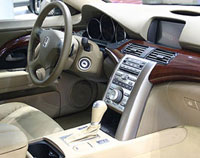 The SH-AWD system is constantly playing with both friction couplings (good, electromagnets allow you to compress and unclench them very quickly and accurately dose the effort). Up to 70% of the torque can be transmitted to the rear axle, and for each wheel up to 100% of this share. As a result, Legend is controlled not only by the steering wheel, but also by traction automatically.
The SH-AWD system is constantly playing with both friction couplings (good, electromagnets allow you to compress and unclench them very quickly and accurately dose the effort). Up to 70% of the torque can be transmitted to the rear axle, and for each wheel up to 100% of this share. As a result, Legend is controlled not only by the steering wheel, but also by traction automatically. Now about Mitsubishi:
The AYC system first appeared on Lancer EVO V GSR (version for the domestic market) in 1998, and on EVO VI was put by order. Starting with the VII generation, the system has become base for almost all configurations. The executive mechanism of the system takes place in the standard differential of high friction in the rear wheels drive. This is also an inter -long differential, but with two frictions of the right and left. And when, at the command of electronics, one of the two frictions joins, the differential ceases to be symmetrical and gives a greater torque to the corresponding wheel. The rear axle is steaming - the stimulus effect is achieved by the application of different traction forces to the right and left wheel! This creates an additional turning point that turns the car to compensate for insufficient rotation. In addition, the active redistribution of the moment between the rear wheels allows you to more fully realize the traction power of the electronics can always serve a greater torque for the moment, which is more pressed to the road and has the best coating adhesion.
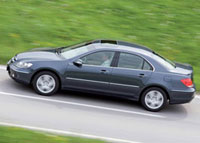 It would seem the same as Honda. Nevertheless, the difference between the machines is fundamental, and it is hidden inside the center differential. Starting from the VII generation EVO, the center differential, as well as on all previous evolutions, is symmetrical, that is, it distributes the torque between the axes equally. But instead of viscous factories, another friction coupling is worth the locking mechanism. It is controlled by an on -board computer using a hydraulic drive. The system is called - the ACD interdosseous differential - Active Center Differential. Moreover, the driver can choose one of the three operating modes of electronic locking snow, gravel or asphalt.
It would seem the same as Honda. Nevertheless, the difference between the machines is fundamental, and it is hidden inside the center differential. Starting from the VII generation EVO, the center differential, as well as on all previous evolutions, is symmetrical, that is, it distributes the torque between the axes equally. But instead of viscous factories, another friction coupling is worth the locking mechanism. It is controlled by an on -board computer using a hydraulic drive. The system is called - the ACD interdosseous differential - Active Center Differential. Moreover, the driver can choose one of the three operating modes of electronic locking snow, gravel or asphalt. What's in the dry residue?
Purely theoretically, the advantage on the SH-AWD system, which can more flexibly play with traction on both rear wheels. But the advantage in the implementation of traction on the side of Mitsubishi. Because Honda is able to convey back up to 70% of torque no longer allow electromagnetic friction couplings. And evolution does not have such a restriction: if an active inter -beard differential of ACD is blocked, then up to 100% traction can be transmitted back.
But this is a theory, and now it is time to share what was in practice!
Honda was the first experimental rabbit
I slam the door, conquer the motor. Here this is done by a regular key (in the Japanese version of the chip card, and the start with a button). However, all these are trifles. It is much more important that for Europeans, Honda set the suspension harder, shifting the emphasis on controllability.
 But I felt it a little later. And first, he appreciated the level of acoustic comfort. Immediately after starting the V6 is absolutely invisible, and only when the revolutions reach 4500 mark, the motor as if wakes up. Honda proudly notes that the soundproofing of the model of the top of modern technologies. In motion from monotonous low -frequency sounds (rubber rumble or release, for example), Active noise noise cancellation is protected. With the help of two microphones located in the cabin, it monitors undesirable acoustic accompaniment. And then ANC inverts it and reproduces a signal in antiphase through the speakers of the audio system.
But I felt it a little later. And first, he appreciated the level of acoustic comfort. Immediately after starting the V6 is absolutely invisible, and only when the revolutions reach 4500 mark, the motor as if wakes up. Honda proudly notes that the soundproofing of the model of the top of modern technologies. In motion from monotonous low -frequency sounds (rubber rumble or release, for example), Active noise noise cancellation is protected. With the help of two microphones located in the cabin, it monitors undesirable acoustic accompaniment. And then ANC inverts it and reproduces a signal in antiphase through the speakers of the audio system. The car is generally literally stuffed with modern technologies, a lifting hood with pyropatrons to protect a pedestrian when hitting. Japanese Legend is equipped with an infrared monitor that helps to distinguish between pedestrians in darkness, radar cruise control and the LKAS, Lane-Keeping Assist System, which using the video camera allows automation to hold Legend within the markings lines.
Moreover, the speed of the system is quite enough even for high -speed autobahns. Later LKAS will probably be put on European cars. True, in Russia, the marking lines are irrelevant! And the final point in all this electronic-mechanical history is placed by climate control. It turns out that he can independently adjust his work taking into account the position of the machine regarding the Sun. GPS navigation calculates it! If the luminary on the right, then the electronics automatically reduces the air temperature of the right half of the cabin. Has the car turned, the sun shines on the left? So, now colder air will blow from the left deflectors. In order to have an acceptable weight stuffed with technology, aluminum is widely used in its design. A hood, front wings, some engine details, subframes, and transverse levers are made from it.
In the first lap, I start with the maneuver of the rearrangement. Honda behaves without nervousness, the demolition of the rear axle is easily extinguished by SH-AWD, AVS (this is a stabilization system of course stability) and a light movement of the steering wheel in the very initial phase. Now I turn off the stabilization system and fly into a turn at provocative speed. In theory, the demolition of the front axis should begin, however, instead, the machine smoothly slides outward with all four wheels. I slightly load the front axle with the discharge of gas, and with a light press on the brake with my left foot, then add the thrust, and the car obediently screws into the turn.
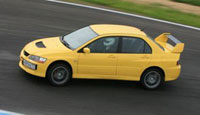 If you break Honda before entering the turn, you can go in the controlled sliding by all wheels. It becomes clear that it can much more than it is required. The car gives an amazing feeling of complete control, predictability and friendliness! But there is a serious negative moment. When I finished testing Honda, the first desire was to open the hood and see where 295 hp hid? Maybe there is not a V6 with a volume of 3.5 liters, but an accidentally clogged motor from a 1.8 liter civic ... there are clear large losses on the transmission, automatic, etc. But still 295 forces in Africa 295 forces. The engine comes to life a little only with the VTEC system after 4500 rp. min. And up to this point, he is some kind of sluggish. You can keep the motor in this range only in manual automatic gearbox mode.
If you break Honda before entering the turn, you can go in the controlled sliding by all wheels. It becomes clear that it can much more than it is required. The car gives an amazing feeling of complete control, predictability and friendliness! But there is a serious negative moment. When I finished testing Honda, the first desire was to open the hood and see where 295 hp hid? Maybe there is not a V6 with a volume of 3.5 liters, but an accidentally clogged motor from a 1.8 liter civic ... there are clear large losses on the transmission, automatic, etc. But still 295 forces in Africa 295 forces. The engine comes to life a little only with the VTEC system after 4500 rp. min. And up to this point, he is some kind of sluggish. You can keep the motor in this range only in manual automatic gearbox mode. Mitsubishi Lancer Evolution behaves completely differently
This is an uncompromising fighter. With the Spartan salon, a minimum set of functions, no climate control with the Sun sensor, or pedestrian protection systems.
There is only a steering wheel, a recaro seat, a motor and that very famous transmission. But the weight in weight, compared to Honda, is more than 400 kg. It immediately becomes clear that comparing these cars is the same as comparing sour with soft!
Naturally, Mitsubishi Lancer Evolution defeated Honda by the time of passing the circle (and this was our main goal). But when I left Evo after three circles driving, I had a wet back. And not because I was scared. It was just very hot in the car, and piloting it in extreme modes is hard physical work (although very pleasant).
Yes, Mitsubishi is better to steer, inhibits, accelerates and behaves in a controlled drift. I will not paint all the advantages of Evik, his balance, ideal controllability, neutral rotation - about this, thank God, entire volumes have already been written. But Mitsubishi Lancer Evolution requires constant concentration, and almost does not forgive errors.
Summary of Maxim Travin
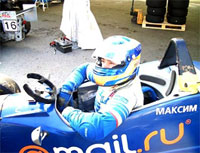 I could not answer that pure performance or comfort plus perfect handling is more important. Probably the correct answer, this is a quote from a children's poem: Dad are different, all kinds of dads are important
I could not answer that pure performance or comfort plus perfect handling is more important. Probably the correct answer, this is a quote from a children's poem: Dad are different, all kinds of dads are important Reference:
Maxim Travin. Candidate to master sport.
He came to the motorsport in 2001. The racing career began with participation in the competition of the VW Polo Cup. Since 2002 - a permanent participant in the championship Formula Rus, repeatedly occupied high places in the final tables of racing.
Source: Auto.mail.ru
Honda Legend Crash Test Video since 2006
Honda Legend Sedan test drive since 2006
Honda Legend Sedan Crash Test since 2006
Krassh Test: Detailed Information33%
Driver and passengers
22%
Pedestrians
40%
Children-passengers







